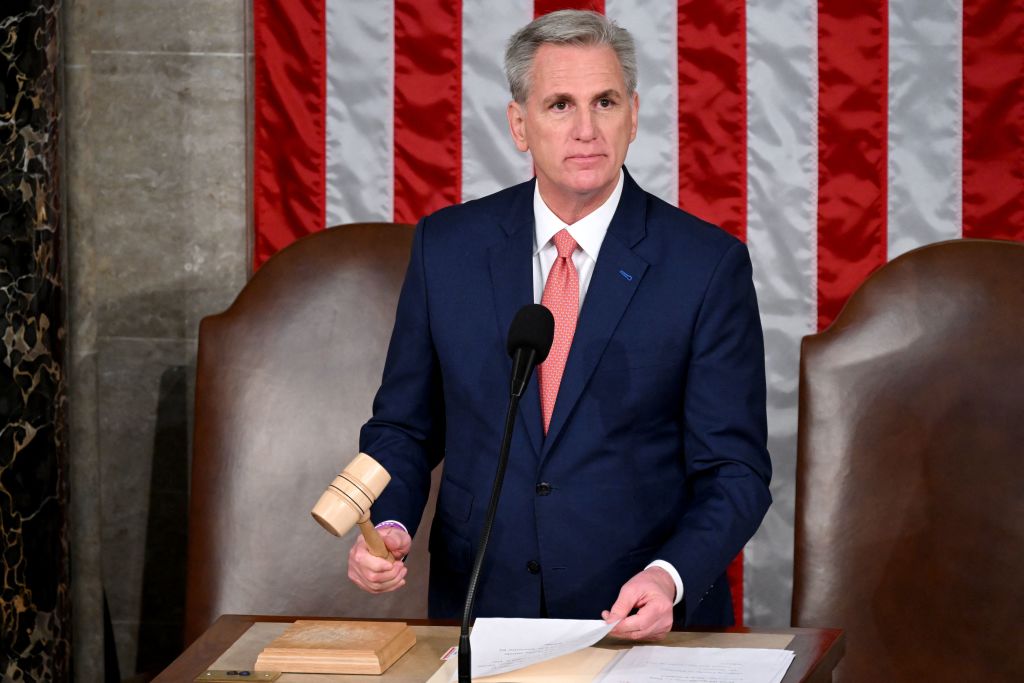With Republican gridlock intensifying and a government shutdown looming, House Speaker Kevin McCarthy sounded close to shifting his strategy last week from appeasing his critics to daring them to oust him as speaker. But instead of putting a stopgap spending bill on the floor and essentially daring hardliners to vote against it, McCarthy ultimately settled for attempting to placate the rebels in his caucus by advancing individual spending bills with stringent spending cuts.
The drama has illustrated how moving a motion to vacate, or oust the speaker, isn’t the only way a small but belligerent minority of the majority party can exercise outsize control over McCarthy. Last week’s rebellion among GOP hardliners ground House business to a halt when they tanked consideration of a defense spending bill twice, voting against the “rule” that allows for its consideration on the House floor.
“You can cripple the speakership in other ways,” Matt Glassman, a senior fellow at Georgetown University’s Government Affairs Institute, tellsThe Dispatch. “You don’t control the House unless you control the procedural majority. … Quite clearly, [McCarthy] doesn’t currently control the procedural majority in the House.”
In other words, a majority (or 218 lawmakers) that defers to the leader’s agenda and coalesces behind the basic procedural steps necessary to govern, such as votes establishing the rules of debate for a particular bill.
It’s not so much that the office of speaker itself has been fundamentally weakened—though the concessions McCarthy made in January to secure the gavel, such as placing hardline members on the powerful Rules Committee and lowering the threshold needed to call for a motion to vacate, did weaken the office somewhat. It’s more that the slim majority empowers small groups to effectively grind governance to a halt.
“The rebels, they could move the motion to vacate, or they could just like, vote against every rule,” Glassman says.
Part of what is happening in the House is a breakdown of “the model that we have for the last 30 years of strong speakers jamming their members,” Daniel Schuman, a policy director with internet advocacy group Demand Progress, says. That model led to the sidelining of rank-and-file members of both parties under Democratic and Republican speakers. But McCarthy made a huge concession when he put three hardline members on the Rules Committee, giving them sway over which legislation comes up for votes on the House floor.
When the governing majority seems paralyzed, as it does now, the potential remedy is never more than two years away, Glassman says. If Republicans pad their majority in future elections, “you can imagine them undoing all the changes on the Rules Committee,” Glassman says. “And really putting the Freedom Caucus in the meat locker next Congress and really just ignoring them.”
But for now, seemingly unconvinced that McCarthy will look to centrists or Democrats for support, hardliners are turning the screws on GOP leadership successfully. This week’s strategy of voting on individual spending bills, even though that will do nothing to avert a fast-approaching government shutdown, is one example. Hardliners have demanded Republican leadership make good on its earlier promise to consider individually all 12 funding bills for 2024. They’ve also wrung concessions from McCarthy to cut an additional $60 billion from the amount lawmakers planned to spend. Over the weekend, appropriators cut an additional $4 billion from nondefense spending bills that fund the departments of Agriculture and State, as well as other agencies.
Assuming there isn’t another revolt against the rule vote, the House will take up that vote series tonight. If all Democrats vote no as expected, Republicans can afford to lose only three of their own and pass the rule. Rep. Marjorie Taylor Greene has said she is a no due to provisions for more aid to Ukraine.
In order to fund the government for the next fiscal year, which begins Sunday, both chambers still need to pass 12 appropriations bills, either separately or bundled into “mini-” or “omni-” bus packages. The House has passed only one spending bill so far. The Senate has passed none.
Meanwhile, Majority Leader Chuck Schumer’s eleventh-hour plan to temporarily fund the government involves advancing a continuing resolution (CR) by the week’s end.
The Senate will spend the week seeking to advance the CR: It’ll take a procedural vote this evening on a previously passed House bill to fund the FAA. It’s unclear what exactly the government funding patch could look like more broadly, but it’s likely to be short-term (think a month or six weeks) and be a “clean” CR, or one without policy add-ons. It may include no or very little Ukraine aid, because Sen. Rand Paul has said he would object to speedy consideration for any measure that contains more money for Ukraine. Aid to Ukraine, as well as disaster relief funding, may be considered separately at a later date, teeing up another fight for later in the year.
After procedural votes today and Wednesday, there could be a final vote sometime this weekend, assuming all 100 senators give unanimous consent, perilously close to when government funding runs out.
But all eyes will then move back to the House, and it’s unclear how GOP leadership will respond to whatever the Senate ultimately advances. On Tuesday, McCarthy refused to answer what he deemed “hypotheticals” about the Senate’s version of a CR.
He will likely need to rely on House Democrats to pass a CR—likely the same coalition of lawmakers who voted to approve the debt ceiling deal earlier this year—but that risks turning his intra-party cold war into a hot one: If he does so, McCarthy’s critics may finally make good on their threat to bring up a vote to oust him. Then McCarthy’s options appear to be between a shutdown and his own job security.
“These guys are able to hold the floor hostage, despite the vast majority of members of Congress being fully willing to keep the government open,” Liam Donovan, a lobbyist and former Republican Senate campaign operative, tells The Dispatch. “It’s forcing the speaker into a situation where he has to somehow either please these members or look elsewhere for the votes.”
Schuman observes that it’s McCarthy’s “narrow margin” that gives members “enough power to make his life really miserable. And he’s not willing to expand his coalition,” by looking for support from Democrats.
Instead, McCarthy is “trying to make it to the finish line for this Congress,” Schuman says likely in hopes that Republicans will “have a bunch of new members so these five or six won’t matter.”
Perhaps to that end, McCarthy has offered only light criticism for the thorns in his side.“You have to keep the government open,” he told reporters Monday. “If people want to close the government, it only makes them weaker. Why would they want to stop paying the troops or stop paying the border agents or the Coast Guard? I don’t understand how that makes you stronger. I don’t understand what point you’re trying to make.”
Presented Without Comment
On the Floor
The House will vote Tuesday on four spending bills. The House also may vote on a variety of bills that would designate postal offices.
The Senate will move Tuesday on a procedural vote to advance a stopgap bill to fund the government.
Key Hearings
The Senate Committee on Agriculture, Nutrition, and Forestry holds a hearing Wednesday on foreign ownership in U.S. agriculture. Information and livestream available here.
On Wednesday, the House Foreign Affairs Committee Middle East, North Africa and Central Asia Subcommittee holds a hearing Wednesday entitled “No Incentives for Terrorism: U.S. Implementation of the Taylor Force Act and Efforts to Stop ‘Pay to Slay.’” The hearing features former Deputy National Security Adviser Elliot Abrams. Information available here.
A House Committee on Homeland Security subcommittee on Counterterrorism, Law Enforcement, and Intelligence holds a hearing Wednesday on addressing the rise of terrorism in Africa. Information and livestream available here.
A House Committee on House Administration subcommittee on modernization holds a hearing Wednesday on the modernization of the Government Accountability Office (GAO). Information available here.
The Senate Select Committee on Intelligence holds a hearing Wednesday on “Countering China’s Malign Influence Operations in the United States.” Experts include the Hoover Institution’s Glenn Tifffert, Freedom House’s Sarah Cook, and Alan Kohler, former assistant director of the Federal Bureau of Investigation’s Counterintelligence Division. Information available here.
The Senate Committee on Rules and Administration holds a hearing Thursday on “Artificial Intelligence and the Future of our Elections.” Information and livestream available here.
The House Oversight and Accountability Committee holds a hearing Thursday on “the basis for an impeachment inquiry of President Joseph R. Biden, Jr.” Witnesses will include Bruce Dubinsky, a forensic accountant, former Assistant Attorney General Eileen O’Connor, and law school professor and Fox News contributor Jonathan Turley. Information here and livestream here.






Please note that we at The Dispatch hold ourselves, our work, and our commenters to a higher standard than other places on the internet. We welcome comments that foster genuine debate or discussion—including comments critical of us or our work—but responses that include ad hominem attacks on fellow Dispatch members or are intended to stoke fear and anger may be moderated.
With your membership, you only have the ability to comment on The Morning Dispatch articles. Consider upgrading to join the conversation everywhere.